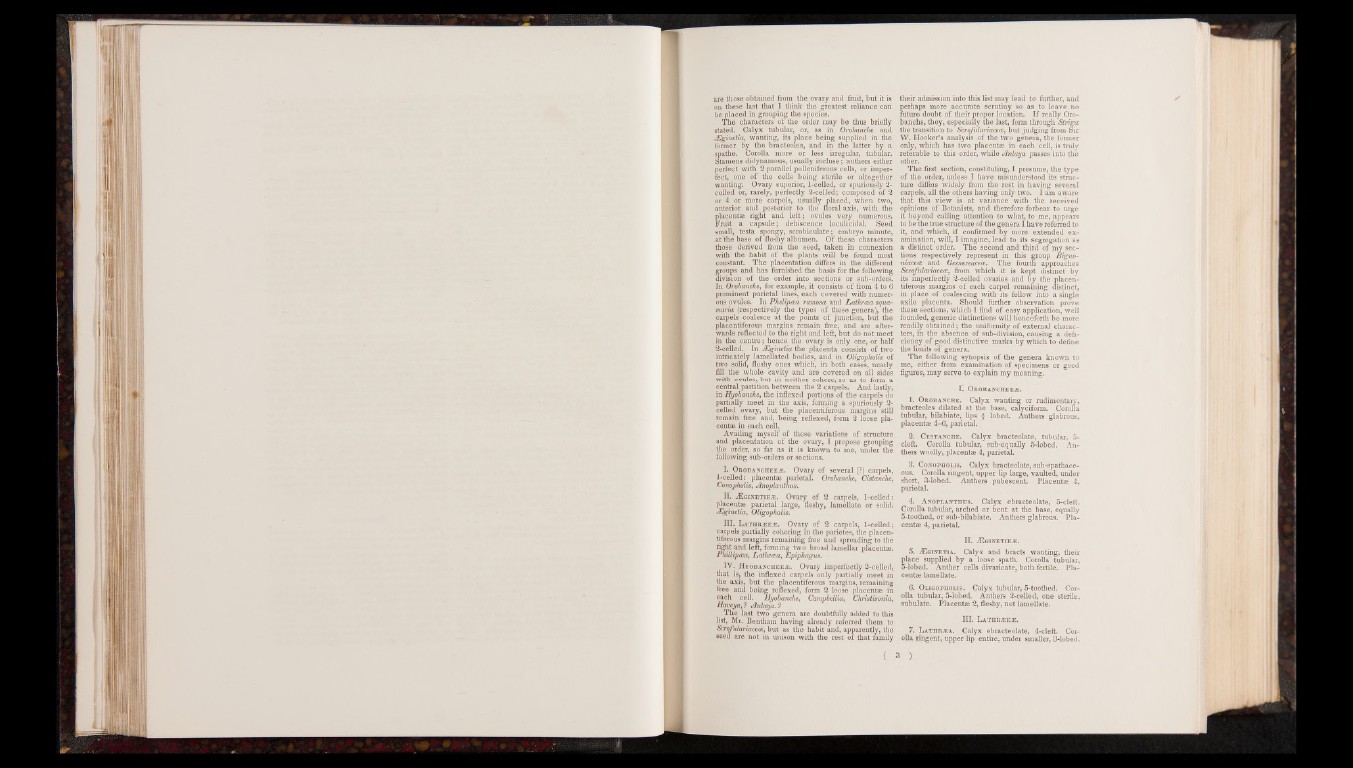
are those obtained from the ovary and fruit, but it is
on these last that I think the greatest reliance can
be placed in grouping the species.
The characters of the order may be thus briefly
stated. Calyx tubular, or, as in Orobanche and
JEginetia, wanting, its place being supplied in the
former by the bracteoles, and in the latter by a
spathe. Corolla more or less irregular, tubular.
Stamens didynamous, usually incluse; anthers either
perfect with 2 parallel polleniferous cells, or imperfect,
one of the cells being sterile or altogether
wanting. Ovary superior, 1-celled, or spuriously 2-
celled or, rarely, perfectly 2-celled; composed of 2
or 4 or more carpels, usually placed, when two,
anterior and posterior to the floral axis, with the
placentae right and left; ovules very numerous.
Fruit a capsule; dehiscence loculicidal. Seed
small, testa spongy, scrobiculate; embryo minute,
at the base of fleshy albumen. Of these characters
those derived from the seed, taken in connexion
with the habit of the plants will be found most
constant. The placentation differs in the different
groups and has furnished the basis for the following
division of the order into sections or sub-orders.
In Orobanche, for example, it consists of from 4 to 6
prominent parietal lines, each covered with numerous
ovules. In Phelipcea ramosa and Lathrcea squa-
maria (respectively the types of these genera), the
carpels coalesce at the points of junction, but the
placentiferous margins remain free, and are afterwards
reflected to the right and left, but do not meet
in the centre; hence the ovary, is only one, or half
2-celled. In JEginetia the placenta consists of two
intricately lamellated bodies, and in Oligopholis of
two solid, fleshy ones which, in both cases, nearly
fill the whole cavity and are covered on all sides
with ovules, but in neither cohere, so as to form a
central partition between.the 2 carpels. And lastly,
in Hyobanche, the inflexed portions of the carpels do
partially meet in the axis, forming a spuriously 2-
celled ovary, but the placentiferous margins still
remain free and, being reflexed, form 2 loose placentae
in each cell.
Availing myself of these variations of structure
and placentation of the ovary, I propose grouping
the order, so far as it is known to me, under the
following sub-orders or sections.
I. Orobanchee.®. Ovary of several (?) carpels,
1-celled: placentae parietal. Orobanche, Cistanche,
Conopholis, Anoplanthus.
II. JEginetie.®. Ovary of 2 carpels, 1-celled:
placentae parietal large, fleshy, lamellate or solid.
JEginetia, Oligopholis.
III. Lathrjse.£. Ovary of 2 carpels, 1-celled;
carpels partially cohering in the parietes, the placentiferous
margins remaining free and spreading to the
right and left, forming two broad lamellar placentae.
Pkillipcea, Lathrcea, Epiphagus.
IV. Hyobancheeje. Ovary imperfectly 2-celled,
that is, the inflexed carpels only partially meet in
the axis, but the placentiferous margins, remaining
free and being reflexed, form 2 loose placentae in
each cell. Hyobanche, Campbellia, Christisonia,
Haveya, ? Aulaya. ?
The last two genera are doubtfully added to this
list, Mr. Bentham having already referred them to
Scrofulariacece, but as the habit and, apparently, the
seed are not in unison with the rest of that family
their admission into this list may lead to further, and
perhaps more accurate scrutiny so as to leave no
future doubt of their proper location. I f really Oro-
banchs, they, especially the last, form through Striga
the transition to Scrofulariacece, but judging from Sir
W. Hooker’s analysis of the two genera, the former
only, which has two placentae in each cell, is truly
referable to this order, while Anlava passes into the
other.
The first section, constituting, I presume, the type
of the order, unless I have misunderstood its structure
differs widely from the rest in having several
carpels, all the others having only two. I am aware
that this view is at variance with the received
opinions of Botanists, and therefore forbear to urge
it beyond calling attention to what, to me, appears
to be the true structure of the genera I have referred to
it, and which, if confirmed by more extended examination,
will, I imagine, lead to its segregation as
a distinct order. The second and third of my sections
respectively represent in this group Bigno-
niacece and Gesnereacece. The fourth approaches
Scrofulariacece, from which it is kept distinct by
its imperfectly 2-celled ovaries and by the placentiferous
margins o f each carpel remaining distinct,
in place of coalescing with its fellow into a single
axile placenta. Should further observation prove
these sections, which I find of easy application, well
founded, generic distinctions will henceforth be more
readily obtained; the uniformity of external characters,
in the absence of sub-division, causing a deficiency
of good distinctive marks by which to define
the limits of genera.
The following synopsis of the genera known to
me, either from examination of specimens or good
figures, may serve to explain my meaning.
I. Orobancheeje.
1. Orobanche. Calyx wanting or rudimentary,
bracteoles dilated at the base, calyciform. Corolla
tubular, bilabiate, lips f lobed. Anthers glabrous,
placentas 4-6, parietal.
2. Cystanche. Calyx bracteolate, tubular, 5-
cleft. Corolla tubular, sub-equally 5-lobed. Anthers
woolly, placentas 4, parietal.
3. Conopholis. Calyx bracteolate, sub-spathace-
ous. Corolla ringent,upper lip large, vaulted, under
short, 3-lobed. Anthers pubescent. Placentas 4,
parietal.
4. Anoplanthus. Calyx ebracteolate, 5-cleft.
Corolla tubular, arched or bent at the base, equally
5-toothed, or sub-bilabiate. Anthers glabrous. Placentae
4, parietal.
II. iGGINETIEiE.
5. JEginetia. Calyx and bracts wanting, their
place supplied by a loose spath. Corolla* tubular,
5-lobed. Anther cells divaricate, both fertile. Placentae
lamellate.
6. Oligopholis. Calyx tubular, 5-toothed. Corolla
tubular, 5-lobed. Anthers 2-celled, one sterile,
subulate. Placentas 2, fleshy, not lamellate.
III. LATHRJEEiB.
7. Lathrjea. Calyx ebracteolate, 4-cleft. Corolla
ringent, upper lip entire, under smaller, 3-lobed.